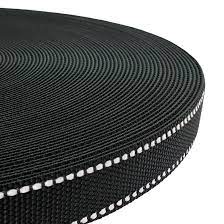Binding and webbing are two terms often encountered in the textile, manufacturing, and product design industries. Despite their similar functions in reinforcing and finishing fabric edges, they differ significantly in material, application, and design. Understanding these differences is crucial for selecting the appropriate material for specific projects.
Overview of Binding
Binding refers to the process or material used to encase the edges of fabric. It serves both a functional and aesthetic purpose, protecting the fabric edges from fraying while providing a finished look. Binding materials vary widely, including bias tape, ribbon, or custom-sewn fabric strips.
Types of Binding
- Bias Tape: Fabric cut on the bias (at a 45-degree angle to the weave) for flexibility, ideal for curved edges.
- Ribbon: A woven strip used for both decoration and edge finishing on straight edges.
- Fabric Strips: Strips of fabric sewn to the edges, matching or contrasting with the main material.
Overview of Webbing
Webbing, on the other hand, is a strong, woven fabric available in various widths and weights, designed for bearing weight and providing support. It is commonly used in furniture, automotive safety, climbing equipment, and as straps for bags and sporting goods. Webbing can be made from various materials, including nylon, polyester, and polypropylene.
Types of Webbing
- Flat Webbing: Often used in seat belts and bag straps, providing strength and flexibility.
- Tubular Webbing: Used in climbing and rescue operations for its superior strength and cushioning effect.
- Printed Webbing: Customized webbing with printed designs or logos for branding or identification purposes.

Key Differences
- Material Composition: Binding is typically made from softer materials like fabric or ribbon, while webbing is constructed from stronger, more durable materials such as nylon, polyester, or polypropylene.
- Functionality: Binding is primarily used for finishing fabric edges to prevent fraying and add aesthetic appeal. Webbing is designed for applications requiring strength and durability, such as lifting, securing, or supporting weight.
- Application Areas: Binding is common in clothing, quilting, and home decor. Webbing finds its use in industrial applications, outdoor gear, automotive safety, and furniture manufacturing.
Selection Criteria
When choosing between binding and webbing, consider the following factors:
- Strength Requirements: For high-strength applications, webbing is the preferable choice. For aesthetic edge finishes, binding is suitable.
- Material Compatibility: The choice between binding and webbing should complement the primary material in terms of texture, strength, and appearance.
- Environmental Conditions: Webbing materials like nylon and polyester offer resistance to water, UV, and abrasion, making them suitable for outdoor and harsh environments.
Conclusion
The decision between binding and webbing comes down to the specific needs of the project, including strength requirements, material compatibility, and environmental conditions. Understanding the distinct characteristics and applications of each can guide designers, manufacturers, and hobbyists in making informed choices for their projects.